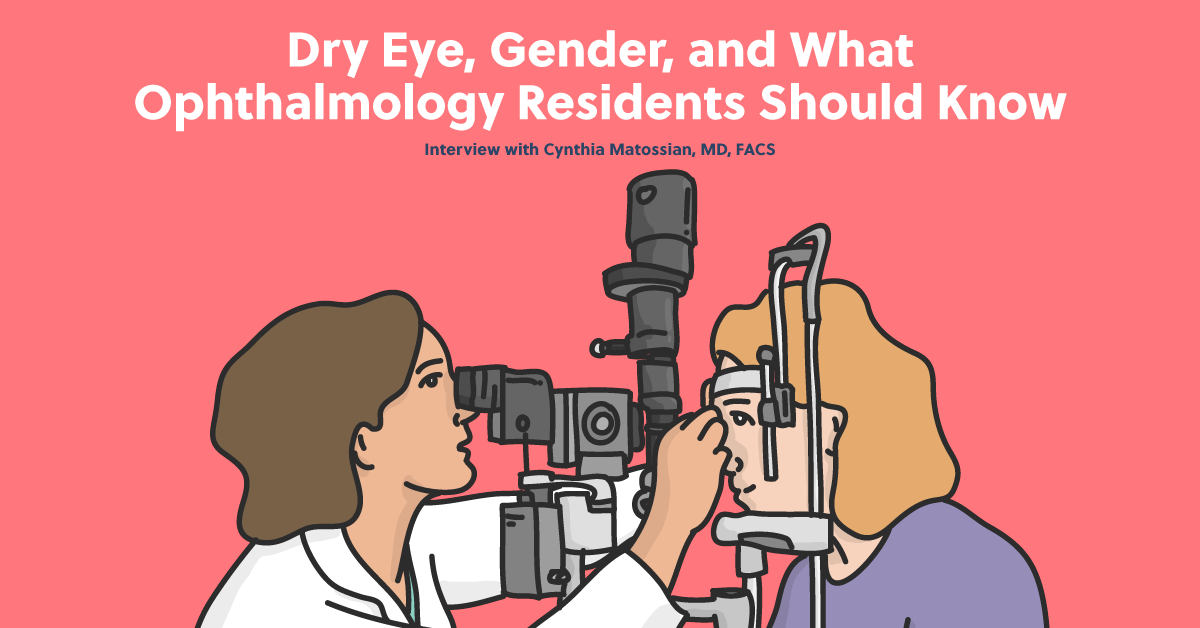Dry eye disease (DED) is an extremely common and multifactorial disease of the ocular surface. The increase in screen time, pollution, the use of systemic medications, and other unavoidable aspects of the modern world are major factors in the rise of dry eye and ocular surface disease.
When it comes to treating patients, it’s important to know not only the general causes of DED, but the more specific factors that come to play in your patient’s life.
Dr. Cynthia Matossian, MD, FACS is a leading surgeon and dry eye specialist, and an entrepreneur and innovator in the field of ocular surface disease treatment. We sat down with her to discuss the lesser-known aspects of dry eye, and what ophthalmologists can do to improve patients’ overall quality of life. The following is a synopsis of the conversation, edited for length and clarity.
Causes of dry eye disease
Many of the causes of dry eye disease are so ingrained in everyday life that patients often neglect to mention them. It’s important for ophthalmologists and staff to ask patients the right questions in order to determine which habits and symptoms are a result of DED. In many cases, patients may not even think to mention these during their appointments.
Another major factor—particularly for the increasing number of patients working remotely—is increased screen time. People are spending more and more time looking at screens, which means less frequent blinking. In a world that revolves around monitors, computers, iPads, smartphones, and other digital devices, to avoid eye strain it’s important to remember the “20-20-20 rule”: every 20 minutes, look at something 20 feet away for 20 seconds. However, not many of us adhere to this guideline. For that reason, men are catching up to women when it comes to the prevalence of dry eye. Screen time is one common denominator between the two.
Environmental factors are a major cause for DED. Many people have no idea of the impact that their lifestyle can have on their ocular health. Problem is—these factors aren’t reported. Here are a few common ones:
- Medications with “anti-” (antihistamines, antidepressants, anti-cholesterol)
- Makeup and eyelash extensions
- Vaping and smoking
- Pollen
- Pollution
- Systemic diseases (e.g., rheumatoid arthritis impacts the ocular surface)
- CPAP for sleep apnea
- Having a fan while sleeping, or air conditioning
- Surgical procedures like blepharoplasty (eyelids may not close fully)
All of these add up over time. “At some point, the straw breaks the camel’s back,” says Dr. Matossian. Most of us are exposed to dry-eye contributing factors throughout our daily lives, so it’s up to ophthalmologists to narrow down the main cause.
Dry eye disease versus dry eye syndrome
There’s no agreed-upon nomenclature. Some say “ocular surface disease,” because this phrase is more inclusive and includes conditions like allergic conjunctivitis. After all, there is often an overlap between allergies and dry eye, says Dr. Matossian. Others say dry eye syndrome, while others are adamant that it’s dry eye disease, due to its progressive and chronic nature.
More granular terms include “meibomian gland dysfunction” or even “dysfunctional tear syndrome.” However, it really depends on how you think about it, says Dr. Matossian. If you see it as chronic and progressive, then DED might be your phrasing of choice.
Diagnosing DED
Clearly, there are many factors that can contribute to the development of DED. However, many patients may not even be fully aware that their eyes are being affected at all and may fail to report. This is where the
need for proper communication and comprehensive eye exams becomes apparent.
Ask them questions about their habits. Ask them questions that might open their eyes to symptoms that they may not initially have noticed. “Do you find yourself needing to blink often? Does your vision change or fluctuate throughout the day?” These questions will help get to the root of the problem.
Speaking to patients about dry eye
First and foremost, be specific. Ask patients questions that will return clear, useful answers. Patients might not be aware of their actions or not even notice certain symptoms unless prompted.
Furthermore, know who you’re speaking to. Because your patients will not want to be dismissed as hypochondriacs, they might omit essential information. Consider the number of patients who think of their eye dryness as “normal,” when in fact it’s a crucial symptom! Try to draw out what you need to know while being cognizant of what your patient may be thinking.
Treating patients with dry eye
Dry eye disease is multifactorial. Therefore, it’s important to be aware of what you can do, and where there may be opportunities for referral. Speak with patients’ rheumatologists, endocrinologists, and other physicians to ensure that they’re getting the best care possible.
There are numerous alternatives to exposing the ocular surface to multiple drops with preservatives for long periods of time. New diagnostic tests and therapeutic treatments ensure that patients with dry eye disease don’t have to suffer. In most cases, ophthalmologists can help them at least feel more comfortable.
Helping dry eye patients to improve their quality of life is extremely gratifying, says Dr. Matossian: ophthalmologists are very fortunate to have all kinds of wonderful new drug delivery approaches around the time of cataract surgery. It’s an exciting time to be in the field.
